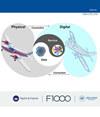数字孪生环境下基于多层神经网络和机器视觉的机械运动数据采集方法
引用次数: 2
摘要
背景:数字孪生需要物理设备和虚拟模型之间的虚拟现实映射和优化迭代。在数字孪生环境中,物理设备的机械运动数据采集是实现精确的虚拟和物理同步的必要条件。然而,依靠PLC(可编程逻辑控制)的传统方法无法收集各种机械运动状态数据。此外,很少有研究将机器视觉用于设备的虚拟和物理同步。为此,本文提出了一种基于多层神经网络和机器视觉的机械运动数据采集方法。方法:首先,设计各种不同颜色和形状的视觉标记,用于标记物理设备。其次,提出了一种基于霍夫变换和直方图特征的识别方法,分别实现了形状特征和颜色特征的识别。然后,将多层神经网络模型引入到视觉标记定位中。利用dropout算法对神经网络进行训练,实现视觉标记的跟踪和定位。为了验证所提出的方法,选取了1000个样本。结果:实验结果表明,当视觉标记的尺寸大于6mm时,识别算法的识别成功率可以达到95%以上。在多摄像头的实际操作环境中,可以更准确地定位识别点。此外,多层神经网络还可以简化双眼和多眼视觉的摄像机标定过程。结论:本研究为数字孪生环境下物理设备机械运动数据的采集提供了一种有效的方法。多摄像机冗余拍摄下物理实体的姿态和形状数据感知有待进一步研究。本文章由计算机程序翻译,如有差异,请以英文原文为准。
Mechanical movement data acquisition method based on the multilayer neural networks and machine vision in a digital twin environment
Background: Digital twin requires virtual reality mapping and optimization iteration between physical devices and virtual models. The mechanical movement data collection of physical equipment is essential for the implementation of accurate virtual and physical synchronization in a digital twin environment. However, the traditional approach relying on PLC (programmable logic control) fails to collect various mechanical motion state data. Additionally, few investigations have used machine visions for the virtual and physical synchronization of equipment. Thus, this paper presents a mechanical movement data acquisition method based on multilayer neural networks and machine vision. Methods: Firstly, various visual marks with different colors and shapes are designed for marking physical devices. Secondly, a recognition method based on the Hough transform and histogram feature is proposed to realize the recognition of shape and color features respectively. Then, the multilayer neural network model is introduced in the visual mark location. The neural network is trained by the dropout algorithm to realize the tracking and location of the visual mark. To test the proposed method, 1000 samples were selected. Results: The experiment results shows that when the size of the visual mark is larger than 6mm, the recognition success rate of the recognition algorithm can reach more than 95%. In the actual operation environment with multiple cameras, the identification points can be located more accurately. Moreover, the camera calibration process of binocular and multi-eye vision can be simplified by the multilayer neural networks. Conclusions: This study proposes an effective method in the collection of mechanical motion data of physical equipment in a digital twin environment. Further studies are needed to perceive posture and shape data of physical entities under the multi-camera redundant shooting.
求助全文
通过发布文献求助,成功后即可免费获取论文全文。
去求助
来源期刊

Digital Twin
digital twin technologies-
自引率
0.00%
发文量
0
期刊介绍:
Digital Twin is a rapid multidisciplinary open access publishing platform for state-of-the-art, basic, scientific and applied research on digital twin technologies. Digital Twin covers all areas related digital twin technologies, including broad fields such as smart manufacturing, civil and industrial engineering, healthcare, agriculture, and many others. The platform is open to submissions from researchers, practitioners and experts, and all articles will benefit from open peer review.
The aim of Digital Twin is to advance the state-of-the-art in digital twin research and encourage innovation by highlighting efficient, robust and sustainable multidisciplinary applications across a variety of fields. Challenges can be addressed using theoretical, methodological, and technological approaches.
The scope of Digital Twin includes, but is not limited to, the following areas:
● Digital twin concepts, architecture, and frameworks
● Digital twin theory and method
● Digital twin key technologies and tools
● Digital twin applications and case studies
● Digital twin implementation
● Digital twin services
● Digital twin security
● Digital twin standards
Digital twin also focuses on applications within and across broad sectors including:
● Smart manufacturing
● Aviation and aerospace
● Smart cities and construction
● Healthcare and medicine
● Robotics
● Shipping, vehicles and railways
● Industrial engineering and engineering management
● Agriculture
● Mining
● Power, energy and environment
Digital Twin features a range of article types including research articles, case studies, method articles, study protocols, software tools, systematic reviews, data notes, brief reports, and opinion articles.
 求助内容:
求助内容: 应助结果提醒方式:
应助结果提醒方式:


